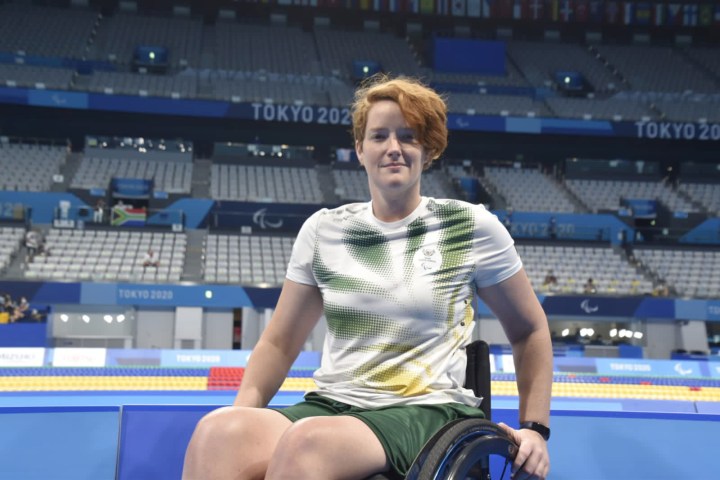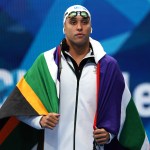TOKYO 2020
Kat Swanepoel is a South African superwoman who swims for hope

Paralympic swimmer Kat Swanepoel has faced many challenges, yet she keeps rising above the hardship.
When Kat Swanepoel speaks about life-changing events she refers to them as “bumps in the road” or “bad luck”. She chronicles the effects of degenerative multiple sclerosis and then punctuates it with a positive. Sometimes the English language doesn’t have enough words to describe things adequately. The word “inspirational”, while relevant, is too soft.
This is a story of an incredible young woman with an indomitable spirit who played hockey and squash until she was 21 and is now representing South Africa at the Tokyo Paralympics at the age of 34. But it’s the last 13 years that are jaw-dropping.
They have resulted in her being diagnosed with a degenerative form of multiple sclerosis, consigned to a wheelchair two years later, representing her country at (wheelchair) rugby and basketball, going blind in one eye, having her body get progressively weaker to where she now has no sensation or movement from her chest down, or in half of her arms, to discovering swimming which has saved her life and given her renewed purpose.
In the last few months alone, getting Covid was “another bump in the road”. She overcame that and has now competed at the Paralympics.
In the 150m Individual Medley, only the third time she has raced the event, she sliced nine seconds off her qualifying time.
Superwoman
Swanepoel refers to the fact she’s in Tokyo as a “miracle”. When you listen to her you will understand why. Superwoman is in the house.
“I’ve got a degenerative form of multiple sclerosis. Mine is the progressive one, a much quicker one. I was in my fourth year studying occupational therapy in 2008,” Swanepoel says.
“I started to feel weakness and pins and needles, and the doctors thought I’d damaged a disc in my back. Eventually,” and she stretches out the word, giving you an indication of the process, “they gave me a full diagnosis.
“I started using a wheelchair in 2010 (aged 23). I’d like to say I handled the change with grace, but I became a bit of a hermit and am still grateful that one of my occupational therapist friends said, ‘you know Kat, you can sit at home and be miserable, but eventually fewer and fewer people will come to see you. Or, you can go out and live life. Nothing is going to change your physical disability, but you can change your quality of life.’”
Swanepoel had always been active and enjoyed sport, although gravitated towards team sports. In the prime of her physical life she touched 6ft in height and was a match for any opponent on the squash court or hockey field.
She also thrived in contact situations, although a first broken nose while playing squash was “an accident”. A second broken nose, this time playing wheelchair basketball, a couple of years later was “a rookie error. Note, never hold your hands in front of your face when catching the ball.”
Test of resolve
But, being healthy and active at 21 and then being diagnosed with MS and being confined to a wheelchair at the age of 23 would test the resolve of even the most resilient person.
She had two options: “sit at home feeling miserable for yourself or live life”. She chose the latter.
“For me, the day-night change was when I went to my first wheelchair basketball practice,” she says. “All of a sudden, instead of being the only one with a disability, I was in an environment where disability was the norm.
“There you’ve got the Leons of this world (current TeamSA chef de mission Leon Fleiser) laughing at you when you fall over, and also people know behind the scenes stuff. It makes a big difference.
“I was still working at Weskoppies psychiatric hospital, so I started (wheelchair) basketball with a Pretoria team and moved to Joburg and started with the Eagles in Mandeville.
“When I started playing wheelchair basketball my paralysis was mainly from the hips down. I had good upper body and hand strength. Then, I began to realise that I was losing strength in my arms and also in my core.”
While playing basketball she earned her South African colours, which was to be the first of three sports in which she has represented her country in these last 13 years. “It could have been four,” she adds, pointing out that she broke three national athletics track records over the sprints and 800. “I also did one marathon and a few 32km races.”
While playing basketball, she was introduced to wheelchair rugby. “I was at the Tuks sports arena and the Tuks rugby guys were training. The one guy looked at my hand and said, ‘do you know you’d be eligible to play rugby?’.
“So that’s where I started playing with them. For quite a while I played basketball and rugby which was always interesting to switch between the two roles.”
Lack of vision
She shifts in her chair, the first indication something even bigger is coming.
“The night I was receiving my South African colours for wheelchair rugby I got my retinas detached in both my eyes,” Swanepoel says matter-of-factly.
“It was just bad luck. I had been having issues with my eyes which were linked to MS. At the event, I started seeing flashing lights and realised there was something wrong with my eyes. Initially, I thought I was having just another flare-up because if I’m under extreme stress, or am sick, it tends to speed up the progression of the illness.
“Often one of the first signs of degeneration is my vision. I went to the ophthalmologist, who found both retinas detached. Luckily they lasered the right eye back, but on the left eye I had surgery and stitches, but there were complications. At one stage we thought I’d lose my eye completely, not just go blind.
“I push myself into a lot of different things to escape from reality. If there’s a road bump, get over it. Being well into my 20s, my work helped me put things into perspective — ‘I’ve lost vision in my eye, but I’ve got another eye’.
“I stopped playing rugby before I stopped playing basketball because I was just taking too many knocks, too many hits. I’ve got an ‘uncerebral’ neck and although I’ve broken my leg playing basketball, with rugby you come off the court and you’ve got welts all over you.
“The physicality took a bit of a toll and I was told that with my condition and neck it wouldn’t be safe to continue with.
“So, in 2014 (age 27), I stopped rugby and focused on basketball. I kept going with the national team until the 2016 Rio Paralympic qualifiers. I was the only quad playing basketball, and the qualifiers were in Algeria.
“There I ended up having quite a few seizures after the last match and spent three days in ICU. It made me thankful for the standard of the hospitals in South Africa.” But now her basketball days are over as well.

Kat Swanepoel in action in the Women’s 150-metre IM during day 5 of the 2021 SA Senior Swimming Championship at Newton Park on April 11, 2021 in Port Elizabeth, South Africa. (Photo by Anton Geyser/Gallo Images)
Taking the plunge
She bought a “basic” chair to keep fit, but Swanepoel dedicated herself to her job. It’s not overly dramatic to say that while swimming has helped her get physically stronger, without her job her mental strength wouldn’t have allowed her to get over the “bumps” that have been placed ahead of her in life’s road. She was only encouraged to take up swimming in late 2019, just before the Covid-19 lockdown in March 2020.
Now, every weekday she leaves the house at 6.45am, when she’s off to work as a full time occupational health therapist. “A huge portion of my work is with kids with disabilities and I specialise in wheelchair seating and set up.
“It’s quite a physical job and it’s non-stop. I get home about 5.30 in the afternoon, have a cup of coffee and then it’s to the pool to train. I get home at 8.30-9pm and then it’s the admin and the adult stuff that needs to be done.”
Swanepoel drives an adapted automatic Honda. “It’s my soccer mom’s car as I do deliveries everywhere. I’ve got a lever on the right side where basically if I pull it, it links to the accelerator and if you push it there’s something that goes into your brakes. My right-hand side is stronger than my left.
“With my left hand there’s a cuff that I put my hand into and it rotates a spinner onto the steering wheel. I don’t have to change my grip to turn. Whenever I’m a designated driver I tease my friends that they must really trust me if they’re getting into a car driven by a blind cripple to get around!”
The obvious question is why does she push herself through 15-hour days, given she’s got such a precarious diagnosis?
“If not, then what’s the purpose?” she shoots back. “I think it’s the hard lockdown that taught me, you have to have purpose in your life. You have to have reason to get up and go.
“I think it’s also being involved in a career where you’re enriching someone else’s life. Every single day, if I’m having a bad day or I notice my condition has got worse … I work with people who would give anything to have what I have. I’ve got a home to go back to. I’ve got a degree. I’ve got a car.
“I travel to work between Benoni and Roodepoort and I work in a lot of rural areas and informal settlements. Although some of my clients have less serious physical disability, many have not had the rehabilitation or are as independent as I am.
“And in a lot of cases, they’re in a different socio-economic environment where you just count your blessings with what you have.
“Here in Tokyo, I was having a low day before my competition and the pressure was getting to me a bit and I replayed a voice note they sent me before I left.
“The note said that I’m carrying all of them here with me and I’m representing them. I thought, ‘this isn’t pressure, this is privilege’. I’ve got opportunities which others would kill for.”
For the first time, Swanepoel’s voice begins to quiver. A pause and then she continues.
“Here at the Paralympics, when I saw that Afghanistan flag being brought into the opening ceremony I thought, ‘how I can sit here and feel pressure and be angered with the classification changes that were handed to me recently, when in Afghanistan a lady can’t leave home without wearing a burqa for fear of being killed?’
“So when I saw that Afghanistan were actually represented here, I thought ‘that’s the power of sport, the power of the global community. Who am I to complain about pressure?’”
Covid hurdle
Before going to Croatia in July for her para-swimming classification grading she had been diagnosed with Covid-19.
“Swimming has helped with my strengthening and it’s given me a new lease on life,” Swanepoel says. “Having a very unpredictable degenerative illness you can’t think too far ahead.
“You have to believe that tomorrow will look after itself. All you can do today is pitch up. I can look back three years ago when I was in hospital, getting family called in. My neck was so weak I couldn’t couldn’t keep it up without a brace. How could I ever have believed then that I’d be at the Paralympics? So no, I don’t think about the future.
“But, when I told Theo (coach Theo Verster) in June that I’d been diagnosed with Covid he went cold because he thought ‘that’s it, we say goodbye’.
“But it was incredible how my body has improved from swimming. If I got Covid a few years back it wouldn’t have been easy … swimming has brought physical, mental and social well-being to my life.”
In Croatia in July, Swanepoel was raised two classification classes from an S2 and SM2 classification to S4 and SM4, which puts her into a far stronger group of disabled swimmers. The S4 for instance allows some kicking with the legs, while the South African has no sensation or movement from her chest or in half of her arms.
“Thankfully in Gqeberha earlier this year I had managed to swim two qualification times in the now-new class. The different grading though was a massive shock, disappointing as I think it was overly harsh, and meant a change of events.”
Swanepoel calls it a “miracle” that she’s at the Paralympics. “Because of so many stumbling blocks, it took me a long time to believe I was here,” she adds.” And then the village. There are so many different things to take in. Due to my job — being an OT specialist — I was just checking out all the different disabilities and going into OT mode.
“Oh my word! It’s just a massive privilege to be here and on the second day in the pool, I thought, “wow, I’m in that same water that Tatjana (Schoenmaker) won gold and broke the world record in. I’m really here!”
When she gets home from Tokyo, she will add the agitos Paralympic emblem to the tattoo she has on her left shoulder. “I’m quite tattooed up … my first one was the ankle, then on my right lower arm I’ve got two bass clefs, as I played the bass guitar and violin. I’ve also got a ‘bit of a dare, spontaneous free-handed tattoo’.
“On my back is a phoenix. It says unbowed, unbent, unbroken forever and always rising … rise is a theme of mine. The agitos ‘emblem’ will become three more tail feathers to the phoenix’s tail.”
Swanepoel is determined to continue rising and soaring. And swimming has now become integral to that journey. “I swim for hope. It doesn’t matter what your circumstances are. If you feel you’re dead and buried it’s over … Not just in a sporting sense. If you can’t hold onto hope, you have nothing.”
Superwoman has spoken. DM
Gary Lemke is in Tokyo as chief writer for Team SA.



















 Become an Insider
Become an Insider
Amazing. Superwoman indeed. You go, girl!
Bravo, you are an amazing young woman. Superwoman and more.
Keep up the good work,
With all my admiration, Charlene from Franc